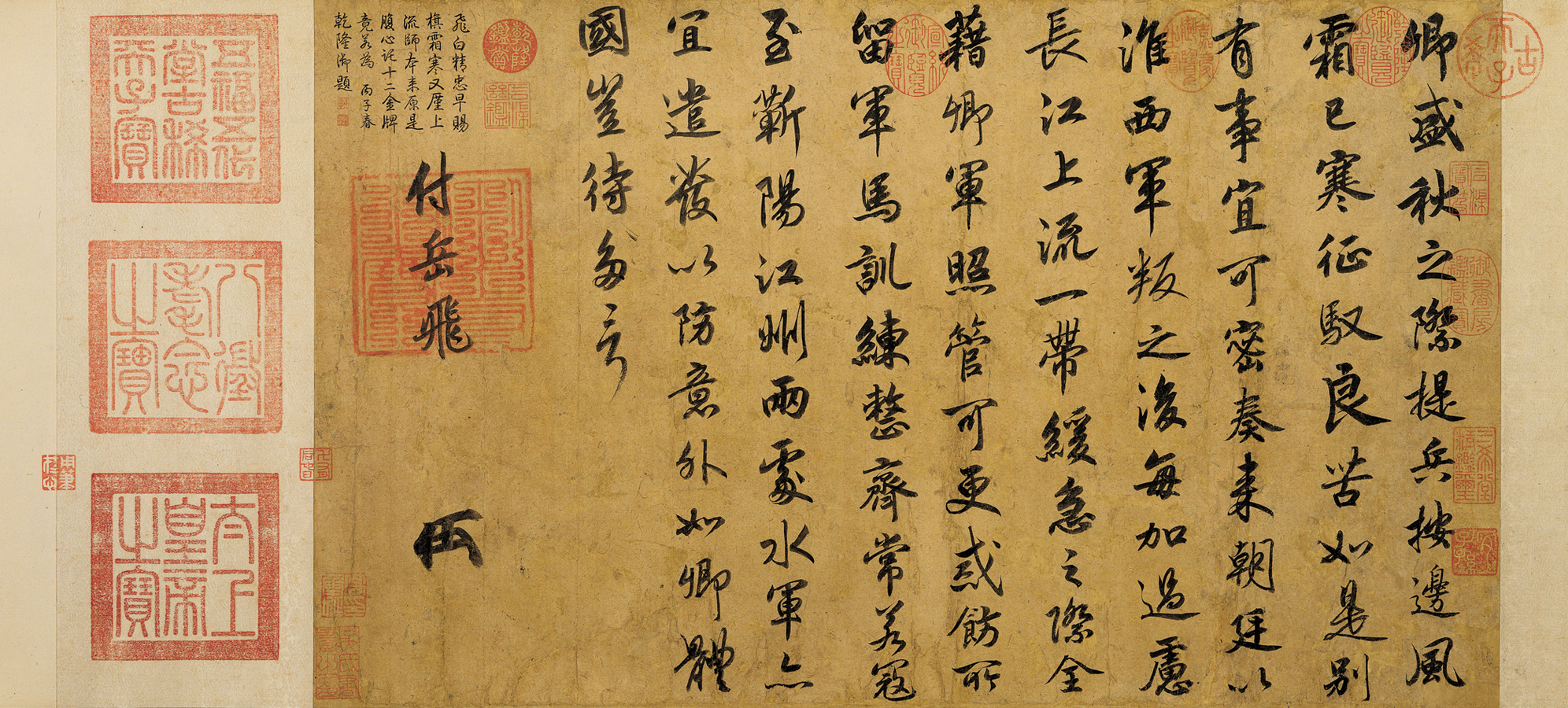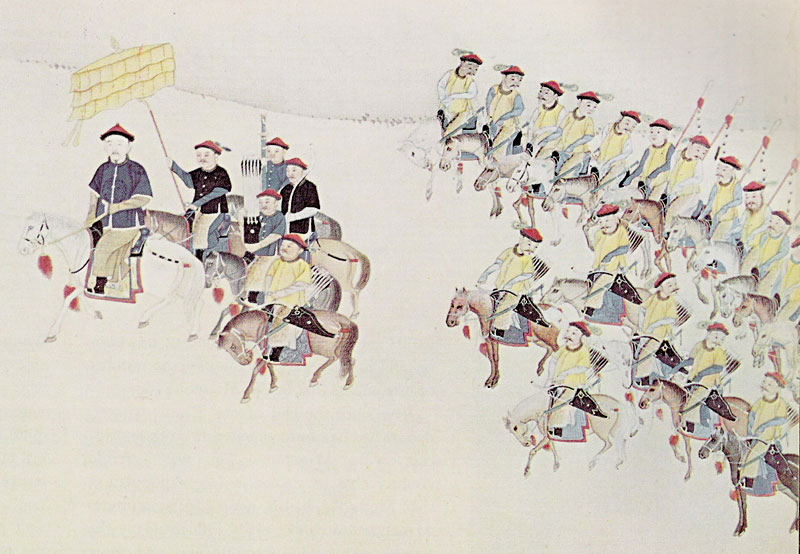|
Memorial To The Throne
A memorial to the throne () was an Official communications of the Chinese Empire, official communication to the emperor of China. They were generally careful essays in Classical Chinese and their presentation was a formal affair directed by government officials. Submission of a memorial was a right theoretically available to everyone from the Taizi, crown prince to a common farmer, but the court secretaries would read them aloud to the emperor and exercised considerable control over what was considered worthy of his time. They were used in imperial China as a means of regulating corrupt local officials who might otherwise have escaped oversight.Brook33 Han dynasty Under the Han dynasty, generally, the reception of memorials was the responsibility of the Government of the Han dynasty#Imperial Counselor, Imperial Secretary tasked with overseeing provincial administration. He was generally required to present any formal memorials, but could reject them for improper formatting.Wang (19 ... [...More Info...] [...Related Items...] OR: [Wikipedia] [Google] [Baidu] |
Official Communications Of The Chinese Empire
Official communications in imperial China, the era which lasted from the 221 BC until AD 1912, required predictable forms and means. Documents flowed down from the emperor to officials, from officials to the emperor, from one part of the bureaucracy to others, and from the emperor or his officials to the people. These documents, especially memorials to the throne, were preserved in collections which became more voluminous with each passing dynasty and make the Chinese historical record extraordinarily rich. This article briefly describes the major forms and types of communication going up to and down from the emperor. Edicts, orders, and proclamations to the people Under Chinese law, the emperor's edicts had the force of law. By the time the Han dynasty established the basic patterns of bureaucracy, edicts or commands could be issued either by the emperor or in the emperor's name by the proper official or unit of the government. Important edicts were carved on stone tablets ... [...More Info...] [...Related Items...] OR: [Wikipedia] [Google] [Baidu] |
Yang Jisheng (Ming Dynasty)
Yang Jisheng (; 16 June 151612 November 1555) was a Chinese court official of the Ming dynasty who held multiple posts during the reign of the Jiajing Emperor. He is remembered as a political opponent of Yan Song, on whose initiative he was arrested and eventually executed. His death, widely perceived as unjust, was followed by significant posthumous veneration of his memory during the late imperial era. In his lifetime, Yang Jisheng was known by the courtesy name Zhongfang (仲芳), but frequently used the art name Jiaoshan (椒山, "Pepper Mountain"). He was also granted the posthumous name Zhongmin (忠愍). Early life Yang Jisheng was born on 16 June, 1516, in the village of Beihezhao, located in Rongcheng County. The son of Yang Fu and Cao Shi, he was the youngest of three brothers, the elder two being named Jichang and Jimei. His early life was troubled by domestic disputes, as hostility grew between Madame Cao and his father's concubine Chen who had given birth to Jim ... [...More Info...] [...Related Items...] OR: [Wikipedia] [Google] [Baidu] |
Fu Youyi
Fu Youyi (傅遊藝) (died August 24, 691), known as Wu Youyi (武遊藝) during the reign of Wu Zetian, was an official of the Chinese Tang dynasty and Wu Zetian's Zhou dynasty, serving as a chancellor briefly after she took the throne in 690. He was known for being the first official to publicly petition her to take the throne and establish her own dynasty and was awarded for his public stance by being promoted within a year from a low-level official to the upper echelon of the imperial administration. In 691, however, he was accused of having even greater ambitions and arrested; he committed suicide. It is not known when Fu Youyi was born, but it is known that he was from Ji County (汲縣, in modern Xinxiang, Henan). As of 690, when Wu Zetian was serving as empress dowager and regent over her son Emperor Ruizong, he was serving as an assistant imperial censor (), when he led a group of some 900 people from the Guanzhong region to publicly petition, outside the palace, the abol ... [...More Info...] [...Related Items...] OR: [Wikipedia] [Google] [Baidu] |
Tien Gow
Tien Gow or Tin Kau () is the name of Chinese gambling games played with either a pair of dice or a set of 32 Chinese dominoes. In these games, Heaven is the top rank of the civil suit, while Nine is the top rank of the military suit. The civil suit was originally called the Chinese (華) suit while the military suit was called the barbarian (夷) suit (see Wen and wu and Hua–Yi distinction) but this was changed during the Qing dynasty to avoid offending the ruling Manchu people, Manchus. The highly idiosyncratic and culture-specific suit-system of these games is likely the conceptual origin of Suit (cards), suits, an idea that later is used for playing cards. Play is counter-clockwise. Dice game Throwing Heaven and Nine (掷天九), or ''Kwat-P'ai'' (骨牌) as reported by Ng Kwai-shang in 1886, is a game of chance where players try to beat each other with a higher combination from a pair of Chinese dice with red 1 and 4 pips. Of the 21 possible combinations, 11 are ranked in a ... [...More Info...] [...Related Items...] OR: [Wikipedia] [Google] [Baidu] |
Rebellion Of Cao Qin
The Rebellion of Cao Qin () was a day-long uprising in the Ming dynasty capital of Beijing on August7, 1461, staged by Chinese general Cao Qin (; died 1461) and his Ming troops of Mongol and Han descent against the Tianshun Emperor (r. 1457–1464). Cao and his officers launched the insurrection out of fear of being persecuted by Tianshun. Tianshun had just gained back the throne from his half-brother the Jingtai Emperor, who rose to power during the 1449 Tumu Crisis. The rebellion was a failure: three of Cao's brothers were killed during the ensuing battle, and Cao Qin was forced to commit suicide during a last stand against imperial troops storming his Beijing residential compound. The rebellion marked the high point in political tension over allowing Mongols to be employed in the Ming military command structure. Ming Chinese officials often made recompense with Mongol subordinates for military merits while at the same time strategically relocating their troops and fami ... [...More Info...] [...Related Items...] OR: [Wikipedia] [Google] [Baidu] |
Official Communications Of The Chinese Empire
Official communications in imperial China, the era which lasted from the 221 BC until AD 1912, required predictable forms and means. Documents flowed down from the emperor to officials, from officials to the emperor, from one part of the bureaucracy to others, and from the emperor or his officials to the people. These documents, especially memorials to the throne, were preserved in collections which became more voluminous with each passing dynasty and make the Chinese historical record extraordinarily rich. This article briefly describes the major forms and types of communication going up to and down from the emperor. Edicts, orders, and proclamations to the people Under Chinese law, the emperor's edicts had the force of law. By the time the Han dynasty established the basic patterns of bureaucracy, edicts or commands could be issued either by the emperor or in the emperor's name by the proper official or unit of the government. Important edicts were carved on stone tablets ... [...More Info...] [...Related Items...] OR: [Wikipedia] [Google] [Baidu] |
Yongzheng Emperor
The Yongzheng Emperor (13 December 1678 – 8 October 1735), also known by his temple name Emperor Shizong of Qing, personal name Yinzhen, was the fourth List of emperors of the Qing dynasty, emperor of the Qing dynasty, and the third Qing emperor to rule over China proper. The fourth son of the Kangxi Emperor, Yongzheng ascended the throne following prolonged disputes over succession. A hard-working ruler, he aimed to create a more effective government, cracked down on corruption and reformed the personnel and financial administration. His reign also saw the formation of the Grand Council (Qing dynasty), Grand Council, an institution that had a major impact on the future of the dynasty. Militarily, Yongzheng continued his father's efforts to consolidate Qing's position in Outer Mongolia and Tibet through force. The Yongzheng Emperor died in 1735 at the age of 56 and was succeeded by his fourth son, who assumed the throne as the Qianlong Emperor. Although his reign was much s ... [...More Info...] [...Related Items...] OR: [Wikipedia] [Google] [Baidu] |
Kangxi Emperor
The Kangxi Emperor (4 May 165420 December 1722), also known by his temple name Emperor Shengzu of Qing, personal name Xuanye, was the third emperor of the Qing dynasty, and the second Qing emperor to rule over China proper. His reign of 61 years makes him the longest-reigning emperor in Chinese history and one of the longest-reigning rulers in history. He is considered one of China's greatest emperors. The third son of the Shunzhi Emperor, Kangxi was enthroned at the age of seven while actual power was held for six more years by the four regents nominated by his father. After assuming personal rule, Kangxi's attempt to revoke the fiefdoms of feudal princes sparked the Revolt of the Three Feudatories, which he suppressed. He also forced the Kingdom of Tungning in Taiwan and Mongols in the north and northwest to submit to Qing rule, and launched an expedition that incorporated Tibet into the empire. Domestically, he initially welcomed the Jesuits and the propagation of ... [...More Info...] [...Related Items...] OR: [Wikipedia] [Google] [Baidu] |
Manchu People
The Manchus (; ) are a Tungusic peoples, Tungusic East Asian people, East Asian ethnic group native to Manchuria in Northeast Asia. They are an officially recognized Ethnic minorities in China, ethnic minority in China and the people from whom Manchuria derives its name. The Later Jin (1616–1636), Later Jin (1616–1636) and Qing dynasty, Qing (1636–1912) dynasties of China were established and ruled by the Manchus, who are descended from the Jurchen people who earlier established the Jin dynasty (1115–1234), Jin dynasty (1115–1234) in northern China. Manchus form the largest branch of the Tungusic peoples and are distributed throughout China, forming the fourth largest ethnic group in the country. They are found in 31 Chinese provincial regions. Among them, Liaoning has the largest population and Hebei, Heilongjiang, Jilin, Inner Mongolia and Beijing have over 100,000 Manchu residents. About half of the population live in Liaoning and one-fifth in Hebei. There are a ... [...More Info...] [...Related Items...] OR: [Wikipedia] [Google] [Baidu] |
Han Chinese
The Han Chinese, alternatively the Han people, are an East Asian people, East Asian ethnic group native to Greater China. With a global population of over 1.4 billion, the Han Chinese are the list of contemporary ethnic groups, world's largest ethnic group, making up about 17.5% of the world population. The Han Chinese represent 91.11% of the population in China and 97% of the population in Taiwan. Han Chinese are also a significant Overseas Chinese, diasporic group in Southeast Asian countries such as Thailand, Malaysia, and Indonesia. In Singapore, people of Han Chinese or Chinese descent make up around 75% of the country's population. The Han Chinese have exerted a primary formative influence in the development and growth of Chinese civilization. Originating from Zhongyuan, the Han Chinese trace their ancestry to the Huaxia people, a confederation of agricultural tribes that lived along the middle and lower reaches of the Yellow River in the north central plains of Chin ... [...More Info...] [...Related Items...] OR: [Wikipedia] [Google] [Baidu] |





